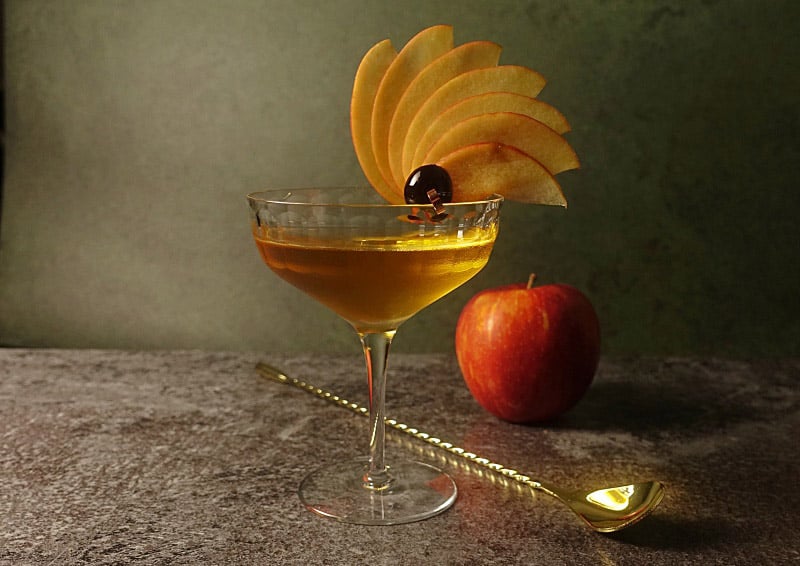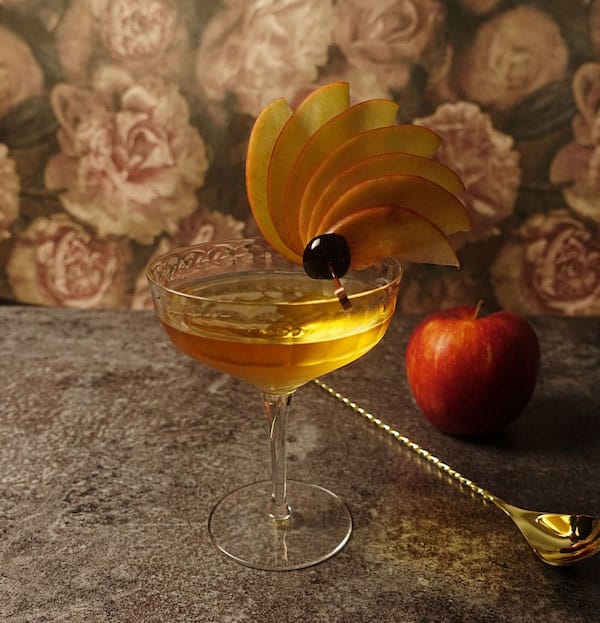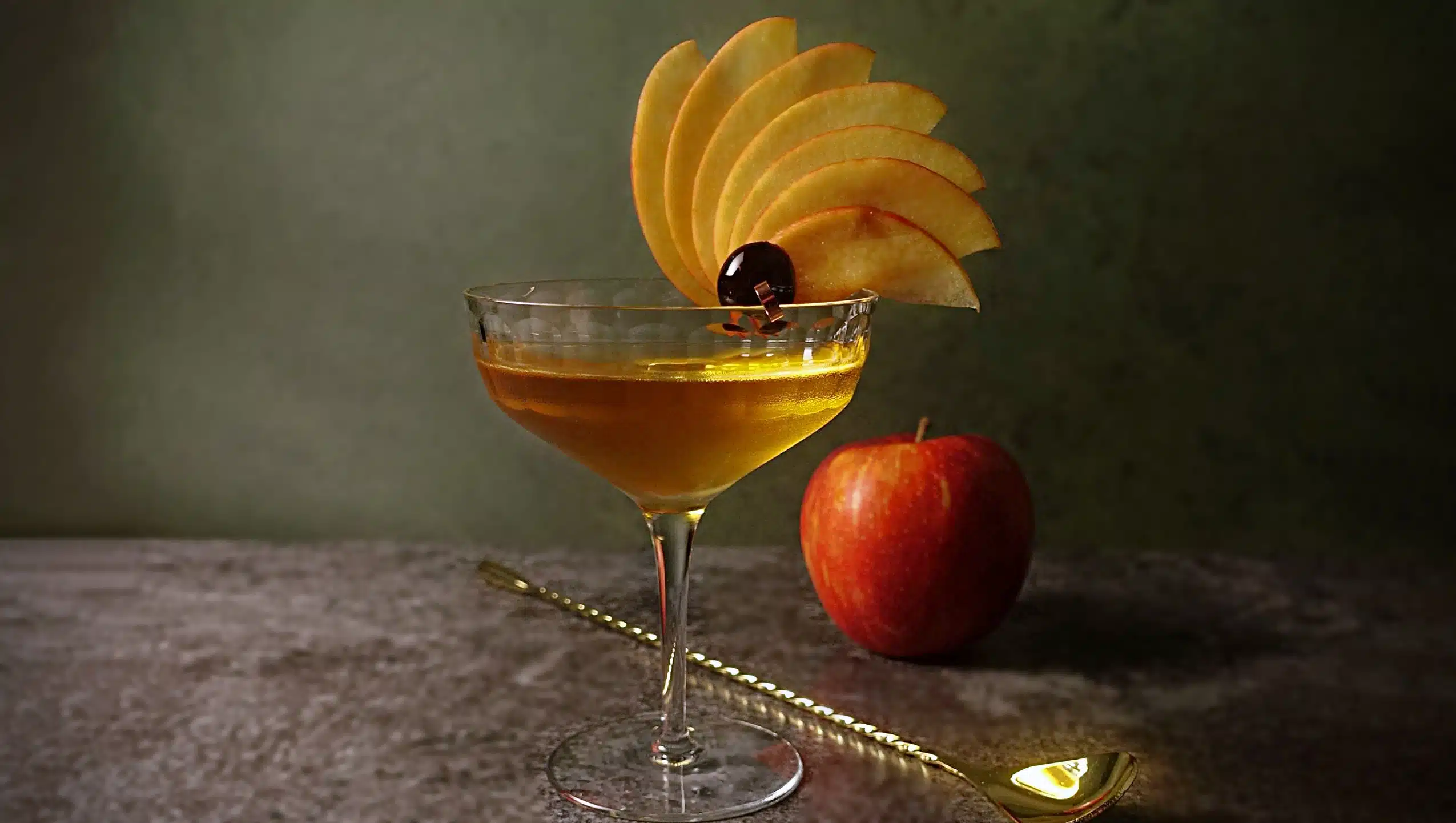You don't see it often on bar menus, still, the Angel Face Cocktail is one of the Unforgettables on the official list of the IBA. The pre-prohibition drink was indeed made unforgettable when it became part of the famous Savoy Cocktail book in 1930.
Quick Facts Angel Face Cocktail
- Method: stirred
- Flavor profile: boozy, well-balanced, slightly fruity
- How to serve it: straight up
- Glassware: coupe glass
- Alcohol content: ~ 27% ABV, 25 grams of alcohol per serving
The drink combines three alcoholic ingredients in equal measures, two of which are high-proof. Here's the recipe and everything else you need to know about the Angel Face Cocktail:

Equipment
- 1 Mixing glass
- 1 Bar spoon
- 1 Jigger
- 1 Hawthorne Strainer
Ingredients
- 1 oz Dry Gin
- 1 oz Calvados
- 1 oz Apricot Brandy
- 1 tsp cold water - optional
- Apple slices - for garnish
Instructions
- Add all the ingredients together with ice into your mixing glass.
- Stir long and well to cool your drink and to achieve the required dilution. Alternatively, you can add a bit of icy water instead.
- Strain your drink into your cocktail glass and garnish with an apple slice or an apple fan.
Nutrition
Ingredients & Recommendations
In its original version, the Angel Face is a three-ingredient cocktail. It consists of equal parts gin, Calvados, and apricot brandy. Modern takes on the drink often dilute this boozy mix with a bit of water or even apple juice.
- Gin: Pick one that compliments the fruity notes from Calvados and Apricot Brandy. A classic type of gin, like dry or London dry, does that well and was also recommended in the original recipe. If you don't have a favorite, try the Rutte Dry Gin or Sipsmith London Dry. Another good choice is Monkey 47.
- Calvados: Calvados is a French apple brandy from Normandy. It has a minimum alcohol content of 40% to 45% vol and a fruity flavor. The individual tasting notes and level of sweetness strongly depend on the brand and the variety of apples used for production. If you don't have a bottle in your home bar, buy a Chateau du Breuil Fine Calvados or a Boulard.
- Apricot Brandy: Here, it gets tricky. The term Apricot Brandy is not clearly defined. Depending on where you are, Apricot Brandy can mean something different. For the Angel Face Cocktail, I recommend Giffard Abricot Du Roussillon Liqueur, though. It has an intense apricot flavor and a pleasant sweetness at 25% ABV. Read below for more info and other options.
- Water or apple juice (optional): Traditionally, the drink is shaken with ice, providing a slight dilution. However, you can also stir the Angel Face to achieve a purer appearance. In this case, add a splash of ice-cold water or apple juice to make up for the deceased dilution of stirring.
Apricot Brandy for the Angel Face Cocktail
The ideal apricot brandy of the Angel Face Cocktail is fruity, actually made from apricots, and has a moderate ABV. As mentioned above, we like to use Giffard Abricot Du Roussillon Liqueur. It's top quality, and we love that it is both made with brandy and apricots. -Neither is a legal requirement.
Merlet Lune and De Kuyper XO Apricot Brandy are also among the favorites. Both work beautifully. - Merlet Lune Apricot Brandy is a little more expensive than Giffard, and De Kuyper is more affordable and a superb budget option.
By the way, in the US, the base spirit must be distilled from grapes, and the final product must have an alcohol content of at least 35%. As you may have noticed, all our top picks are below 35% ABV, because it balances the taste of the Angel Face Cocktail better.

Taste
The Angel Face Cocktail tastes neither overly sweet nor does it tend heavily toward dry or acidic. It is nicely balanced, aromatic, and fruity.
You can taste the apricot and the apple from the Calvados and the apricot liqueur, but you also get some subtle herbal notes from the gin.
With an overall ABV of almost 30%, the Angel Face is quite a boozy drink and can handle a bit of dilution quite well. -Either from shaking or adding cold water. Alternatively, you can also use a splash of chilled apple juice to emphasize the fruity notes. That makes the cocktail a little sweeter and more fruity.
Garnish
We like to garnish our Angel Face Cocktail with a combination of maraschino cherries and apples because both complement the overall taste of the drink extremely well.
However, there's no standard garnish given in the original Angel Face Recipe. You can also serve it minimalistic without any garnish at all.
If you go with our approach, it's a slice of a freshly cut apple or even an apple fan and a maraschino cherry speared on a pick. Another common option for the Angel Face would be an orange peel.
Origin of the Angel Face Cocktail
The Angel Face Cocktail made its first appearance in Harry Craddock's famous Savoy Cocktail book, published in 1930. The book comprises about 750 cocktail recipes. -It goes without saying Craddock himself created only a small number of these, and it seems the Angel Face was not one of them.

Most likely, the fruity cocktail had its origin in France, where Calvados was readily available. Some even suggest that another Harry, namely Harry MacElhone, invented the drink. It supposedly was in Paris, along with other classics like the Bloody Mary, the Boulevardier, etc.
Anyway, Harry Craddock was the first to write down the recipe and asked for equal parts gin, Calvados, and apricot brandy. They ought to be shaken well and strained into a cocktail glass.
Yet, over the years, a different approach developed: Instead of shaking the cocktail, many prefer to prefer it stirred. -And so do we.
Why is the drink called Angel Face?
The name Angel Face supposedly references an American gangster from the pre-prohibition area. The guy went under the name of Abe “Angel Face” Kaminsky.
He was a member of the notorious Prohibition-era Purple Gang. Among other serious crimes, including assault and murder, they were known for armed robbery of speakeasy bars in and around Detroit. They made headlines around the time the Angel Face recipe came up for their involvement with the St. Valentine's Day Massacre in 1929 with their partner, Al Capone.
However, that is only a theory. Nothing is documented or proven in that regard.
Related Cocktails
If you want to try other cocktails with apricot brandy or an apple flavor how about:
- The Paradise Cocktail - a mix of apricot brandy, orange juice, and gin
- The Stone Sour - A fruity twist on the classic Whiskey Sour
- Heißer Kirmes Apfel - a Christmas favorite with gin and apple

